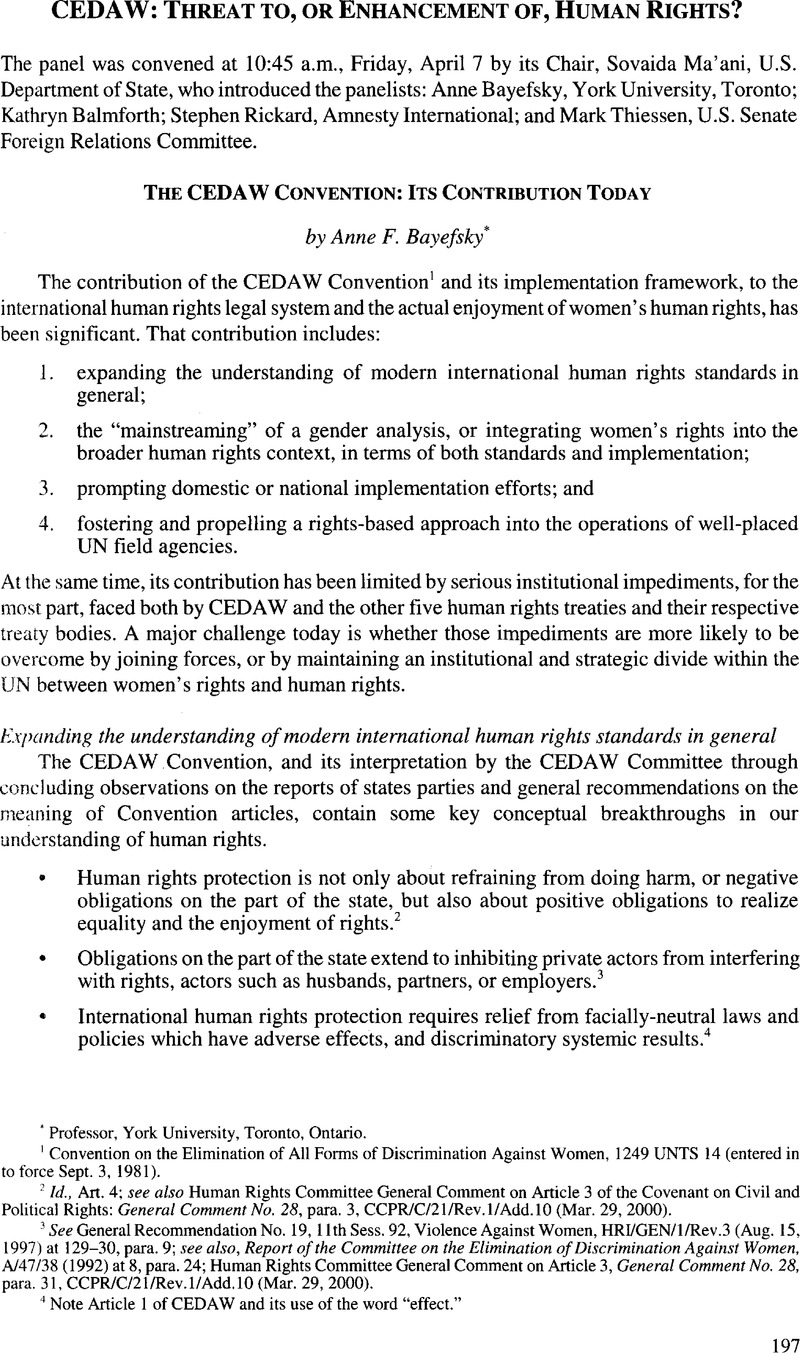Article contents
The CEDAW Convention: Its Contribution Today
Published online by Cambridge University Press: 28 February 2017
Abstract

- Type
- CEDAW: Threat to, or Enhancement of, Human Rights?
- Information
- Copyright
- Copyright © American Society of International Law 2000
References
1 Convention on the Elimination of All Forms of Discrimination Against Women, 1249 UNTS 14 (entered in to force Sept. 3, 1981).
2 Id., Art. 4; see also Human Rights Committee General Comment on Article 3 of the Covenant on Civil and Political Rights: General Comment No. 28, para. 3, CCPR/C/21/Rev.l/Add.lO (Mar. 29, 2000).
3 See General Recommendation No. 19, 11th Sess. 92, Violence Against Women, HRI/GEN/l/Rev.3 (Aug. 15, 1997) at 129-30, para. 9; see also, Report of the Committee on the Elimination of Discrimination Against Women, A/47/38 (1992) at 8, para. 24; Human Rights Committee General Comment on Article 3, General Comment No. 28, para. 31, CCPR/C/21/Rev.l/Add.lO (Mar. 29, 2000).
4 Note Article 1 of CED AW and its use of the word “effect.”
5 See re: civil and political rights for example, Art. 7 (right to vote), and Art. 15 (equality before the law); re: economic, social and cultural rights, Art. 10 (education) and Art. 11 (employment).
6 The Racial Discrimination Committee, the Human Rights Committee, the Economic, Social and Cultural Rights Committee, the Torture Committee and the Committee on the Rights of the Child.
7 See e.g., Joint work plan of the Division for the Advancement of Women and the Office of the High Commissioner for Human Rights, and the Gender Integration into the Human Rights System: Report of ‘he Workshop, United Nations Office at Geneva, May 26-28, 1999, E/CN.6/2000/8 and Annex.
8 For example, in April 1998, the San Francisco Board of Supervisors passed an ordinance to implement the CEDAW principles within the city. HE 152/1985 vp; see also Costa Rican legislation: The Law of Promotion of the Social Equality of Women, 1990; United Nations Development Fund for Women, Bringing Equality Home: Implementing the Convention on the Elimination of All Forms of Discrimination Against Women, 32-34 (1998).
9 Bringing Equality Home, supra note 8 at 35-37; Afra Afsharipour, “Empowering Ourselves: The Role of Women’s NGOs in the Enforcement of the Women’s Convention,” 99 Col. L. Rev. 129, 156, 172 (1999).
10 Bringing Equality Home, supra, note 8 at 6.
11 Optional Protocol to the Convention on the Elimination of All Forms of Discrimination Against Women, GA Res. 54/4, Annex, adopted on Oct. 6, 1999 (not yet in force).
12 Supra, note 1, Article 20(1).
13 See GA Res. 51/68, para. 6, adopted on Dec. 12, 1996.
14 Ways and means of expediting the work of the Committee, CEDAW/C/2000/I/4, Dec. 27, 1999 at 14.
15 Report of the Committee on the Elimination of Discrimination Against Women, at 49, paras. 16-17, A/53/38/Rev.l (1998).
16 The figure is 7.7 years on average between consideration of reports from the same states party, for those states parties reviewed by CEDAW in the last three years (since their meeting time doubled to its current rate).
17 Status of submission of reports by States parties under article 18 of the Convention, CEDAW/C/2000/I/2, (Dec. 5, 1999).
18 There are 35 backlogged (submitted) reports. The Committee considers about 16 reports per year, meaning there is at least a 2-year backlog. See status of submission of reports by States parties under article 18 of the Convention, at 9-10, CEDAW/C/2000/1/2, (Dec. 5, 1999).
- 2
- Cited by


